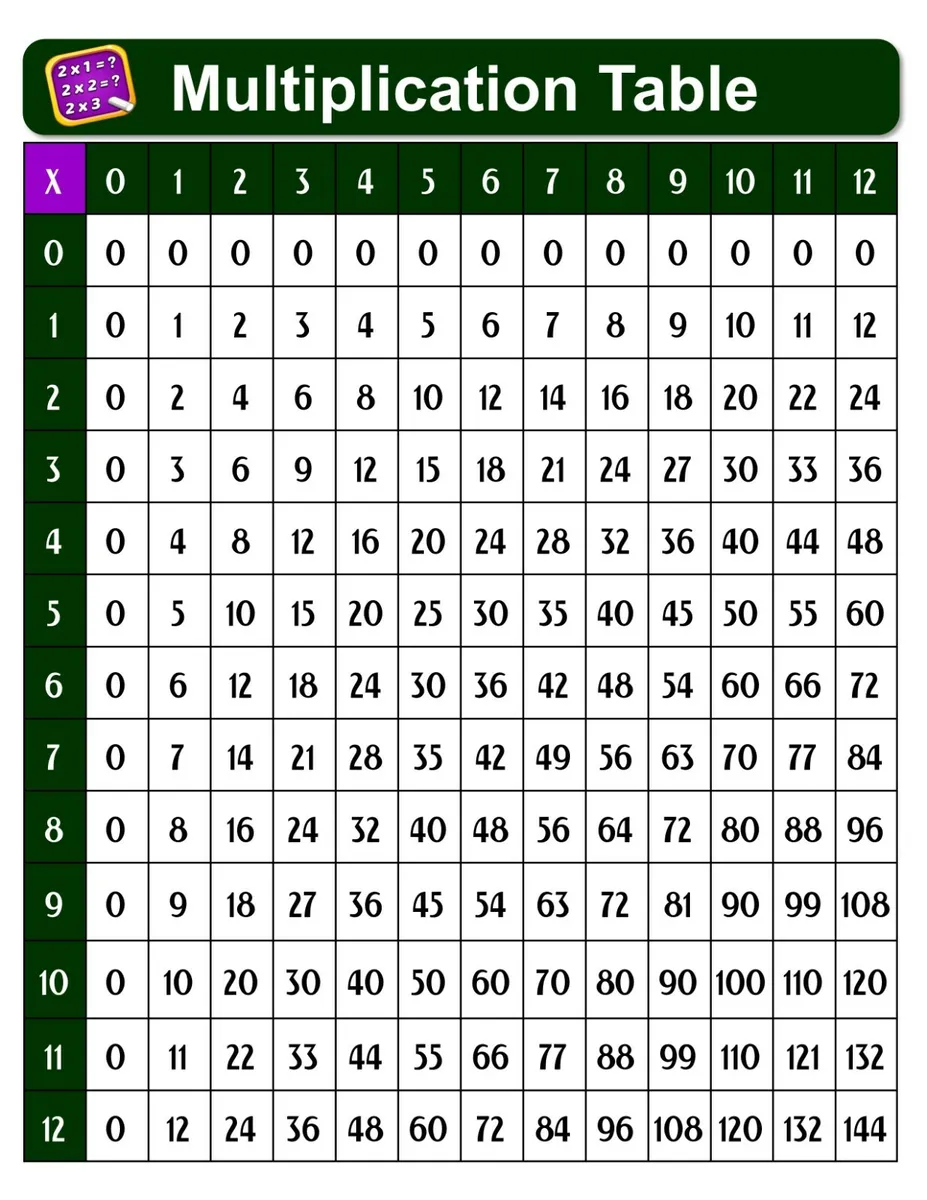Mastering Multiplication: Time Tables Chart for Busy Parents
Welcome to the Exciting World of Multiplication!
Hey there, super parents! Are you on a quest to transform your child into a multiplication maestro? Well, you’re in the right spot! Multiplication is a fundamental skill that forms the building blocks for higher math concepts. And guess what? We can make learning this skill as fun as a hopscotch game. Introducing the timeless classic – time tables charts!
Now, you might be thinking, “But where do I start?” No worries, that’s exactly why this guide exists. We’ll walk through some stellar strategies to use time tables charts effectively, ensuring your kiddo gets to grips with their multiples in no time.
Understanding Time Tables Charts
First things first, let’s chat about what a time tables chart is. Imagine a grid that pairs numbers to show their products – that’s your basic time tables chart. It’s a visual aid that helps children understand the concept of multiplication through pattern recognition and memory reinforcement.
Multiplication may seem daunting at first, but with a time tables chart in their arsenal, your children can visualize the relationships between numbers. This makes multiplying feel less like a memorization chore and more like discovering secrets of the number world.
Why Time Tables Charts Work
Research suggests that using visual aids, such as charts and graphs, can significantly enhance learning and retention. Time tables charts bring a few specific benefits to the math-learning table:
- Patterns: They say math is the language of patterns, and multiplication charts are a fabulous way to spot these patterns easily. This not only helps with memorization but also builds a foundation for advanced mathematical thinking.
- Confidence: With a handy chart, children can quickly reference the answers, building their confidence as they become more familiar with multiplication facts.
- Accessibility: A time tables chart can be accessible anywhere – printed on a poster for wall display, included in a math notebook, or even in digital formats for on-the-go learning.
- Learning Styles: Whether your child is a visual learner, an auditory learner, or a kinesthetic learner, the time tables chart can be adapted to fit their preferred learning style for maximum efficacy and engagement.
How to Introduce Time Tables Charts to Your Child
Okay, let’s dive into how you can introduce this magical chart to your little one. It all starts with a gentle approach:
- Start Small: Begin with the basics. Show your child the 1s and 2s time tables. Once they’re comfortable, you can gradually introduce higher numbers.
- Spot Patterns Together: Spend time with your child looking for patterns in the chart. This can include the diagonal line of squares (1×1, 2×2, 3×3, etc.) or how every number in the 5s row ends in either 5 or 0.
- Use Everyday Examples: Incorporate multiplication into daily life. Whether it’s counting the number of apples in rows at the grocery store or calculating slices of pizza for family game night, use real-world examples to bring the chart to life.
- Positive Reinforcement: Celebrate every small victory. From correctly answering a multiplication question to spotting a new pattern, each step forward deserves a high-five!
All set to boost your child’s numeracy skills?
Creating a Custom Time Tables Chart with Your Child
Why not turn chart creation into a fun DIY project? This activity won’t just give you quality time with your little mathematician but will also make them more invested in using the chart. Here’s how you can create a time tables chart together:
- Gather Your Materials: Grab some colorful pens, a large sheet of paper, and maybe some stickers or markers for decoration.
- Draw the Grid: Outline a 12×12 grid (or 10×10 if you want to start smaller) and take turns filling in the rows and columns with numbers 1 through 12 (or 1 through 10).
- Fill in the Multiples: Starting with the easier rows, fill in the multiples. You might want to color-code or highlight certain rows or columns to emphasize patterns.
- Decorate and Discuss: As you decorate, discuss how the chart works and where you might hang it up for easy access.
Voila! You now have a personalized time tables chart. Remember, the more your child is involved in the creation, the more likely they are to use the chart and, most importantly, have fun with it.
Time Tables Chart Games and Activities
Now, for the really exciting part – games and activities! Turn learning times tables into a playful experience with these ideas:
- Time Tables Tic-Tac-Toe: Create a tic-tac-toe board with time tables answers. To place their X or O, players must correctly solve a multiplication problem.
- Multiplication Bingo: Bingo, but with a twist. Instead of numbers, have products on the bingo cards. Call out multiplication facts, and players will cover the answer if they have it on their card.
- Flashcard Challenge: Make flashcards for different multiplication facts. Flash them quickly and see how many your child can answer correctly in a set amount of time.
The key is making these activities regular yet varied, to keep interest levels high and learning continuous.
Even More Multiplication Mastery Tips
Wondering what else you can do to support your child’s times table mastery? Stay tuned! We’re brimming with tips and ideas that will make multiplication a breeze for your young learner!

Five Things Every Parent Should Know Before Preparing a Time Tables Chart
As a parent, it’s your superpower to engage and empower your child in their educational journey. Before you dive into creating and using a time tables chart, here are five essential tips to keep in mind:
- Understand the “Why”: Children are naturally curious creatures. Explain the purpose behind learning multiplication and how time tables charts can be a useful tool not just for math, but for real-life situations.
- Keep It Fun: Yes, multiplication is serious business, but who says it can’t be fun? Use colors, stickers, and even digital apps to make the learning process visually compelling and interactive.
- Be Patient: Every child learns at their own pace. If your kid doesn’t get it right away, that’s perfectly okay! Patience and continuous encouragement are key to their confidence and progress.
- Involve Them in the Process: Whether it’s creating the chart or tracking progress, involving your child in every step makes the learning process more meaningful and engaging for them.
- Reinforce with Real Life Examples: Regularly pointing out how multiplication is used in everyday life reinforces the importance of knowing how to multiply. It turns abstract numbers into something tangible.
Arm yourself with these tips, mighty parents, and you’re all set to guide your child through their multiplication adventure!
Comprehensive Resources to Supplement Time Tables Learning
To give your young learner the best chance at times table success, you should have a treasure trove of resources at your disposal. Consider worksheets, online multiplication games, math apps, and printable charts. Remember the role technology can play; there are fantastic free and paid apps out there designed to make learning multiplication a blast!
YouTube can also be a goldmine for educational songs and videos that teach multiplication in catchy, memorable tunes. And don’t forget about the classic ‘Schoolhouse Rock!’ Check out their classic ‘Multiplication Rock’ series for some retro fun that’s still super educational.
Utilizing Technology to Master Multiplication
In today’s digital age, why not harness the power of technology to support your child’s education? There are countless apps and websites filled with engaging and interactive multiplication challenges. These can be used to supplement the paper-based time tables chart and add an exciting layer to the learning process.
Popular apps often include timed quizzes, multiple difficulty levels, and progress tracking. These features are great for keeping your child motivated and for providing you with insights into their learning journey.
Monitoring Progress and Adapting Strategies
As your child ventures through the land of multiplication, it’s important to monitor their progress. This doesn’t mean putting pressure on them but rather observing how they use the time tables chart and identifying any patterns in their learning.
If you notice that they excel in certain areas and struggle in others, adapt your teaching strategies to focus on their weak spots, while still celebrating their strengths. Regular mini-assessments or check-ins can be helpful to monitor their comfort with the times tables.
For more great fun click here. For more information see here
Disclaimer
The articles available via our website provide general information only and we strongly urge readers to exercise caution and conduct their own thorough research and fact-checking. The information presented should not be taken as absolute truth, and, to the maximum extent permitted by law, we will not be held liable for any inaccuracies or errors in the content. It is essential for individuals to independently verify and validate the information before making any decisions or taking any actions based on the articles.




